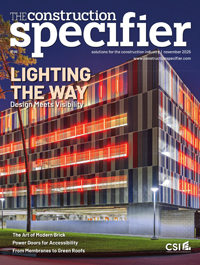Dealing with errors and omissions
 LAW
LAW
Paul Potts
The words ‘errors and omissions’ (E & O) are practically taboo in architectural circles and are rarely spoken—even in private conversations between architects, engineers, and their professional employees. However, errors and omissions in construction documents occur on every project. The unique nature and complexity of the building world is the common explanation for these mistakes. People make mistakes, and generally the more complex the undertaking, the more likely it is that errors will occur. However, the uniqueness and complexity of the undertaking is not the only cause of design mistakes.
A design error is an instruction (or lack of instruction) in the plans and specifications that, if followed by the contractor, will require replacement or correction at a cost (or result in a construction failure). The owner has already paid for the work once at bid time and now must pay for the replacement or correction.
For example, in the remodeling of an auditorium, the mechanical engineer showed new heating/cooling air terminal units above the lobby ceiling. The manufacturer, model number, and design criteria were on the drawings. The contractor purchased the equipment in advance so the project would not be delayed. When it came time to install the equipment, it was discovered the terminals would not fit above the new ceiling and the ceiling could not be lowered any further. Unfortunately, the manufacturer had no interest in taking back the original units.
Responsibility for this error fell to the mechanical engineer. The auditorium lobby ceiling existed before the mechanical units were designed—the engineer could have measured the space above the ceiling during a survey of the building. The owner also provided record drawings of the building. The contractor could have measured the ceiling height, but there was going to be a new ceiling at a lower height than the original, and the contractor assumed the HVAC equipment would fit above it.
In another example, an architect specified non fire-rated doors between classrooms and corridors of a school remodeling project. However, when the fire marshal came to inspect, she rejected the doors and required them to be fire-rated because the corridor above-ceiling space was a return air penum. The first doors were already painted and machined for hardware and could not be returned for credit. In principle, these are classic design errors, but variations on the facts are interminable.
An omission occurs when something required to complete the building or comply with the building codes is not shown on the plans and or in the specifications. For example, a sidewalk between two buildings is required for pedestrian traffic, but this is not shown on the plans. The contractor is entitled to a change order.
Costs for omissions are tempered by reasoning the owner has not paid for the sidewalk twice, as was the case with the heating equipment. For this reason, it can be referred to as a ‘value-added change order.’ However, it is not entirely accurate to say it does not cost extra, because contractors routinely overprice labor on change orders as much as 25 percent or more.
Origins of design mistakes
Most mistakes are caused by the complexity of the design coupled with human limitations. During the programming stage, the first step in the design process, owners discuss their vision and needs for the building with the architects. This stage is mostly conceptual and mathematical, and is managed by a few parties, allowing fewer mistakes. However, programming is followed by design development, and this involves more experts from a wide variety of professional disciplines.
The challenges of design development on large projects are enormous and prove the mettle and talent of skilled and experienced architects, engineers, and designers who perform this work on a daily basis. The task of exchanging hundreds of bits of verbal and written communications between many participants from different professional disciplines often results in mistakes caused by misinterpreted, dropped, or forgotten communications.
There are judgements and calculations made by the hundreds of people about:
- physical spaces and the infrastructure;
- building codes;
- mechanical and electrical codes;
- heating loads;
- cooling loads;
- lighting requirements; and
- the development of the aesthetic ambitions.
Each verbal and written communication and each application of professional knowledge is subject to revision as the project develops.
This is not a manufacturing process that improves with every new model year, but rather involves a new design for each building. Hundreds of specialists, unique in their own knowledge, come together to provide these construction drawings to builders. Not only must the professionals have knowledge of the design requirements, but they must also understand the skills and talents of the trades building the project.
It is absurd to think putting this complex aggregation of information into equally complex construction processes can be done without mistakes, and not just a few. Failures arrive in the form of
- engineering miscalculations;
- lack of attention;
- lack of knowledge;
- inexperience; and
- an overreliance on the trade contractor to finish the job.
This fits with the ‘unique complexity’ argument.
Unique complexity is not the only reason for errors and omissions. Professional miscalculation must also be added to the equation. Contributor’s mistakes in the documents include poor judgement in:
- taking on projects beyond the experience of the firm;
- lack of familiarity with the building codes;
- lack of adequate field surveys;
- inattention;
- missed meetings;
- vacations;
- workers leaving the firm;
- limited surveys of existing buildings; and
- using interns instead of more expensive experienced staff.
Some of these causes obviously result from false economies.








